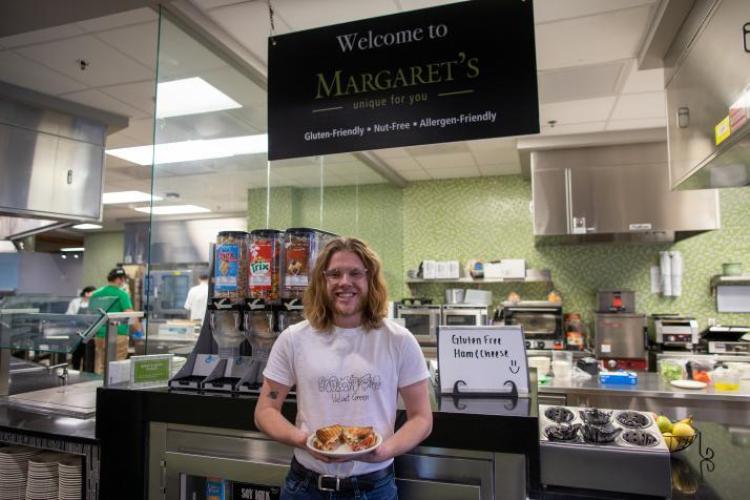
Bobcats with special food needs find tasty and safe food options at on-campus venues

Ohio University knows that food is a major part of the college experience. Students meet with friends for meals at Dining Courts, have study sessions at campus cafés and grab snacks at the markets. College is often one of the first times that a student has full control over their food choices, which can be scary for parents of Bobcats who have special dietary needs. The number of students with food allergies, type 1 and type 2 diabetes and celiac disease is increasing, as is the number of students who are vegetarian or vegan. Eating the wrong foods could give these Bobcats reactions that range from mild discomfort to more severe symptoms that could be life threatening. To make sure all Bobcats have equitable dining options, OHIO’s Culinary Services has several programs that allow everyone to find something delicious to eat, no matter what their dietary needs.
Angie Bohyer, Ohio University’s nutrition educator and registered dietitian, spoke about some of the different options available to Bobcats with special dietary needs. “Culinary Services has really focused on having nutritious and tasty food options for all our students. In 2016, we opened The District on West Green Dining Court, which doesn’t use any tree or ground nuts. It has a station called Margaret’s Made for You with specially-made gluten-free meals as well.” Bohyer works with Shively and Nelson Dining Courts to ensure they have inclusive menus with items such as nut-free pesto and gluten-free soy sauce. In addition, soy and almond milk is available at all Culinary Services’ dining locations.
Students can meet with Bohyer to discuss their dietary needs and develop a healthy eating strategy. One student, Adler Matey, has benefited from OHIO’s diverse menus and meeting with Bohyer. Matey is allergic to gluten, which means he cannot have typical college favorites like pizza, macaroni and cheese or ramen. When he came to Ohio University, he felt he knew what types of foods he could and could not eat, but was “worried about having ‘normal’ foods such as grilled cheese on GF(gluten-free) bread.” He was happy to learn about The District during orientation and later on met with Bohyer. Matey said that Bohyer “has offered great advice for looking out for gluten allergens in [Dining Court] food products I normally thought were typically gluten-free.”
Culinary Services wants students like Matey to be able to make informed decisions about their food. To encourage this, they provide detailed menus with nutritional information, complete ingredient lists and allergens on the menus webpage and in binders at the Dining Courts. The foods in these menus are labeled with icons that show if a food contains eggs, soy, fish/shellfish, lactose or nuts; is low-fat or sugar-free; is Halal-friendly or Kosher-friendly; or is vegetarian, vegan or gluten-free. Students can talk with a manager at any location to find foods that will work for their dietary needs also. In addition, the University has specially trained staff running a gluten-free kitchen at the Central Food Facility. They make a variety of baked goods, which are then sealed to prevent cross-contact and delivered to dining facilities, cafés and retail operations. “We want it to be as simple as possible for students to choose foods that work for their dietary needs without feeling like they’re giving anything up to do so,” said Bohyer.
Matey appreciates these efforts and said, “Eating on campus is great! Especially with all the specialty things they can prepare for me at Margaret‘s, at The District on West Green.” He concluded by giving some advice to Bobcats with special dietary needs, “Don't be afraid to ask for assistance when you are looking for food that is safe to eat. There are trained professionals who are here to help you, and it makes life a whole lot easier with that kind of help.”
Visit Ohio University’s Culinary Services’ website for more information about eating on campus with special dietary needs, or email Angie Bohyer at Bohyer@ohio.edu.
